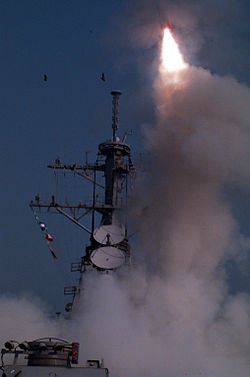- Cruise missile strikes on Iraq (1996)
-
Operation Desert Strike Part of the Iraqi Kurdish Civil War and Iraqi no-fly zones 
Tomahawk cruise missiles launches from the bow of the USS Laboon (DDG 58) to attack selected air defense targets in Iraq, September 3, 1996.Date September 3, 1996 Location Iraq Result US-led coalition victory Belligerents 
US-led Coalition
Republic of IraqCommanders and leaders  Anthony Zinni, William Jefferson Clinton
Anthony Zinni, William Jefferson Clinton Saddam HusseinRecent wars and conflicts
Saddam HusseinRecent wars and conflicts
in the Persian GulfIran-Iraq War – Opera – Gulf War – 1991 uprisings – Provide Comfort – Southern Watch – 1993 cruise missile strikes – Iraqi Kurdish Civil War – Desert Strike – Northern Watch – Desert Fox – Kurdistan Islamist Conflict – Southern Focus – Iraq War – 2011 Bahraini protests
The 1996 cruise missile strikes on Iraq occurred in September 1996 during the Kurdish Civil War. On August 31, 1996, the Iraqi military launched its biggest offensive since 1991 against the city of Irbil in Iraqi Kurdistan. This attack stoked American fears that Saddam intended to launch a genocidal campaign against the Kurds similar to the campaigns of 1988 and 1991. It also placed Saddam in clear violation of United Nations Security Council Resolution 688 forbidding repression of Iraq's ethnic minorities.
On September 3, ships from the USS Carl Vinson (CVN-70) Battle Group, including the USS Laboon (DDG-58) and the USS Shiloh (CG-67), in conjunction with B-52 bombers escorted by F-14D Tomcats from the USS Carl Vinson, launched 27 cruise missiles against Iraqi air defense targets in southern Iraq.[1] A second wave of 17 missiles was launched later that day.[2] The missiles hit targets in and around Kut, Iskandariyah, Nasiriyah, and Tallil.[3]
The Cruise Missile Strike was preliminarily planned to be an aircraft strike by armed aircraft launched from the USS Carl Vinson, including aircraft from squadrons VF-11(F-14D), VF-31(F-14D), VAQ-139(EA-6B), VA-196(A-6E Tram), VFA-113(FA-18), and VFA-25(FA-18). This demonstrates the flexibility and projected power of the United States Navy.
The attacks did not have a substantial effect on Iraq's northern campaign, however. Once it installed the KDP in control of Irbil, Iraqi troops withdrew from the Kurdish region back to their initial positions. The KDP drove the PUK from its other strongholds, and with additional Iraqi help captured Sulaymaniyah. Jalal Talabani and the PUK retreated to the Iranian border, and American forces evacuated 700 Iraqi National Congress personnel and 6,000 pro-Western Kurds out of northern Iraq.[4]
In response to Iraq's moves in the north, the US and UK expanded Operation Southern Watch and the Iraqi no-fly zones from the 32nd parallel to the 33rd parallel.[1]
References
External links

This Middle Eastern history-related article is a stub. You can help Wikipedia by expanding it.
